Certified Kubernetes Application Developer - CKAD
Mock Exams
Mock Exam 2 Solution
In this guide, we will walk you through solving a Kubernetes mock exam with step-by-step instructions on creating deployments, services, configuring taints, tolerations, node affinity, ingress resources, readiness and liveness probes, jobs, multi-container pods, and persistent volumes. Follow along to apply these configurations in your Kubernetes environment.
1. Create a Deployment and Expose It as a NodePort Service
Creating the Deployment
First, create a deployment named my-webapp with the following parameters:
- Image: nginx
- Replicas: 2
- Label: tier=front end (as implied)
Generate a YAML configuration using a dry run and save it to my-webapp.yaml:
kubectl create deployment my-webapp --image=nginx --replicas=2 --dry-run=client -o yaml > my-webapp.yaml
Review the file if necessary, then apply the configuration:
kubectl apply -f my-webapp.yaml
Verify the deployment:
kubectl get deployment
Exposing the Deployment as a Service
Next, expose the my-webapp deployment as a NodePort service with these settings:
- Service Name: front-end-service
- Service Type: NodePort
- Port: 80
- Node Port: 30083 (to be set manually in the YAML)
Generate the service configuration using a dry run:
kubectl expose deployment my-webapp --name front-end-service --type NodePort --port 80 --dry-run=client -o yaml > front-end-service.yaml
Open front-end-service.yaml and add the node port configuration (30083) under the appropriate section. Then, apply the updated configuration:
kubectl apply -f front-end-service.yaml
Verify the service:
kubectl get svc
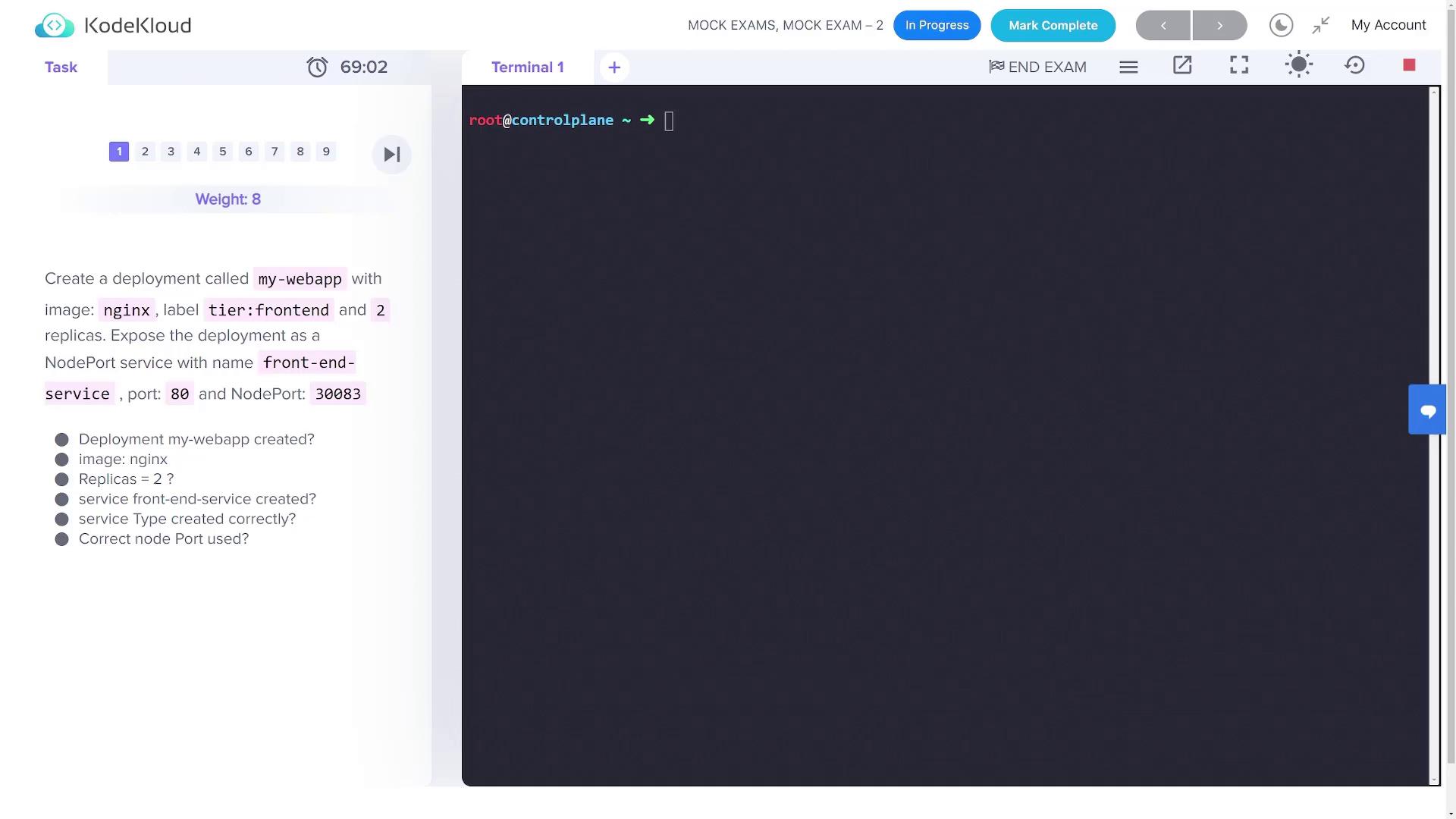
2. Add a Taint to a Node and Create a Pod with a Toleration
Tainting the Node
Check the nodes in your cluster:
kubectl get nodes
Apply a taint on the node named node01 with key app_type, value alpha, and effect NoSchedule:
kubectl taint node node01 app_type=alpha:NoSchedule
Confirm the taint by describing the node:
kubectl describe node node01
Creating the Pod with Toleration
Create a pod named alpha using the redis image. First, generate the pod's YAML configuration:
kubectl run alpha --image=redis --dry-run=client -o yaml > alpha.yaml
Edit the alpha.yaml file to include the following toleration under the pod spec:
tolerations:
- key: app_type
operator: Equal
value: "alpha"
effect: NoSchedule
A complete sample configuration should look like this:
apiVersion: v1
kind: Pod
metadata:
name: alpha
labels:
run: alpha
spec:
tolerations:
- key: app_type
operator: Equal
value: "alpha"
effect: NoSchedule
containers:
- name: alpha
image: redis
restartPolicy: Always
Apply the configuration:
kubectl apply -f alpha.yaml
Verify that the pod is running on node01:
kubectl get pod -o wide
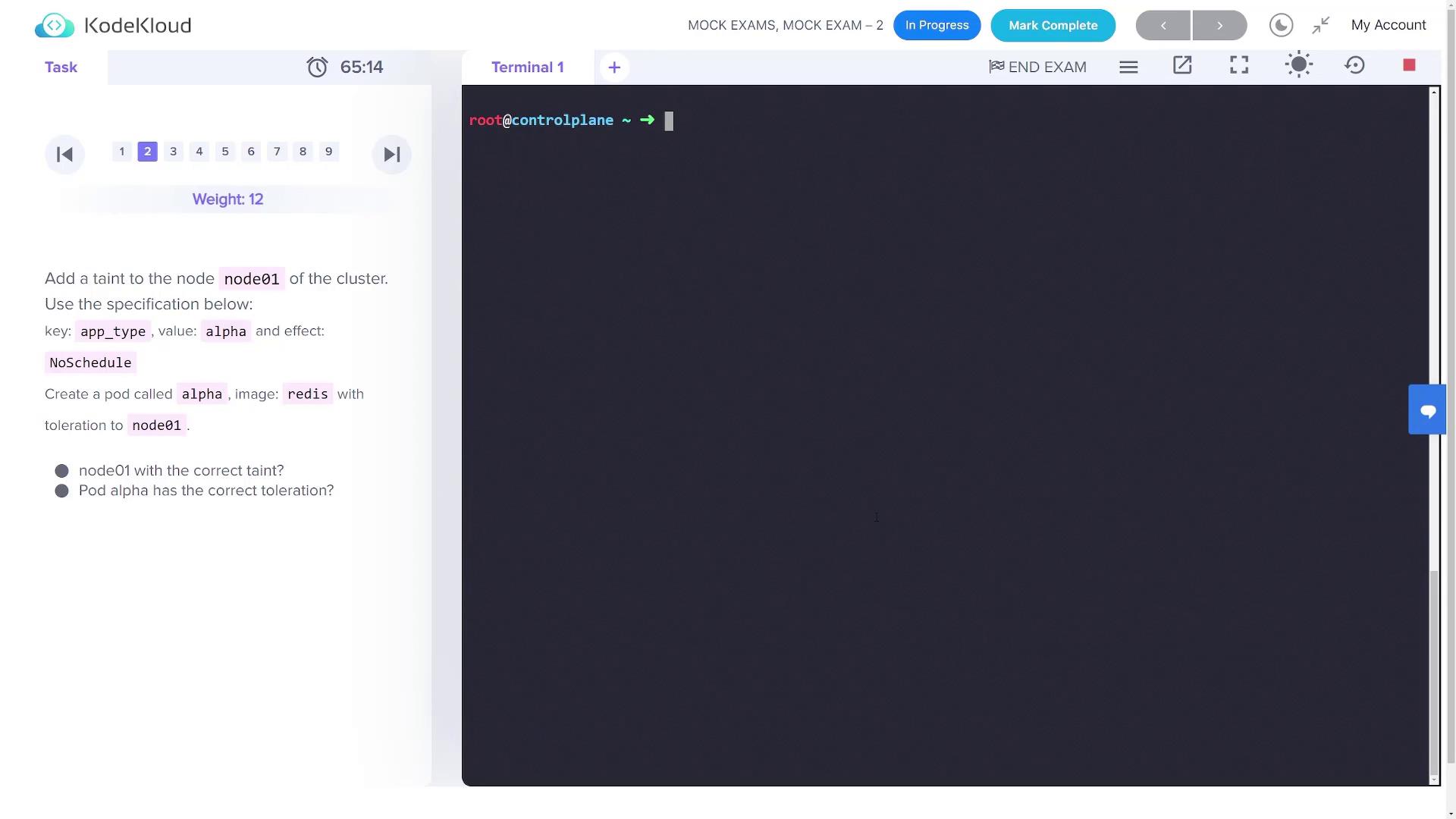
3. Label the Control Plane Node and Create a Deployment with Node Affinity
Labeling the Node
List your nodes to find the control plane node:
kubectl get node
Label the control plane node (assumed to be named controlplane) with app_type=beta:
kubectl label node controlplane app_type=beta
Confirm the label is applied:
kubectl get node --show-labels
Creating the Beta-Apps Deployment with Node Affinity
Create a deployment named beta-apps with the following settings:
- Image: nginx
- Replicas: 3
Generate the YAML configuration:
kubectl create deployment beta-apps --image=nginx --replicas=3 --dry-run=client -o yaml > beta-apps.yaml
Edit the file to add a node affinity section under the pod spec:
spec:
affinity:
nodeAffinity:
requiredDuringSchedulingIgnoredDuringExecution:
- matchExpressions:
- key: app_type
operator: In
values:
- beta
A complete version of the edited deployment YAML will be:
apiVersion: apps/v1
kind: Deployment
metadata:
name: beta-apps
labels:
app: beta-apps
spec:
replicas: 3
selector:
matchLabels:
app: beta-apps
template:
metadata:
labels:
app: beta-apps
spec:
affinity:
nodeAffinity:
requiredDuringSchedulingIgnoredDuringExecution:
- matchExpressions:
- key: app_type
operator: In
values:
- beta
containers:
- name: nginx
image: nginx
resources: {}
Apply the deployment:
kubectl apply -f beta-apps.yaml
Verify that the pods are scheduled on the control plane node:
kubectl get pod -o wide
4. Create an Ingress Resource for the My-Video Service
First, verify the my-video-service details (it listens on port 8080):
kubectl get service
You should see output similar to:
NAME TYPE CLUSTER-IP EXTERNAL-IP PORT(S) AGE
front-end-service NodePort 10.101.45.50 <none> 80:31242/TCP 8m4s
kubernetes ClusterIP 10.96.0.1 <none> 443/TCP 23m
my-video-service ClusterIP 10.97.57.28 <none> 8080/TCP 2m54s
Create an ingress resource so that my-video-service is reachable via the URL ckad-mock-exam-solution.com at the path /video.
Generate the ingress configuration imperatively:
kubectl create ingress ingress --rule="ckad-mock-exam-solution.com/video= my-video-service:8080" --dry-run=client -o yaml > ingress.yaml
Then, adjust the YAML to ensure it follows the proper format. The final configuration should be:
apiVersion: networking.k8s.io/v1
kind: Ingress
metadata:
name: ingress
spec:
rules:
- host: ckad-mock-exam-solution.com
http:
paths:
- path: /video
pathType: Prefix
backend:
service:
name: my-video-service
port:
number: 8080
status:
loadBalancer: {}
Apply the ingress resource:
kubectl apply -f ingress.yaml
Verify the ingress configuration:
kubectl get ingress
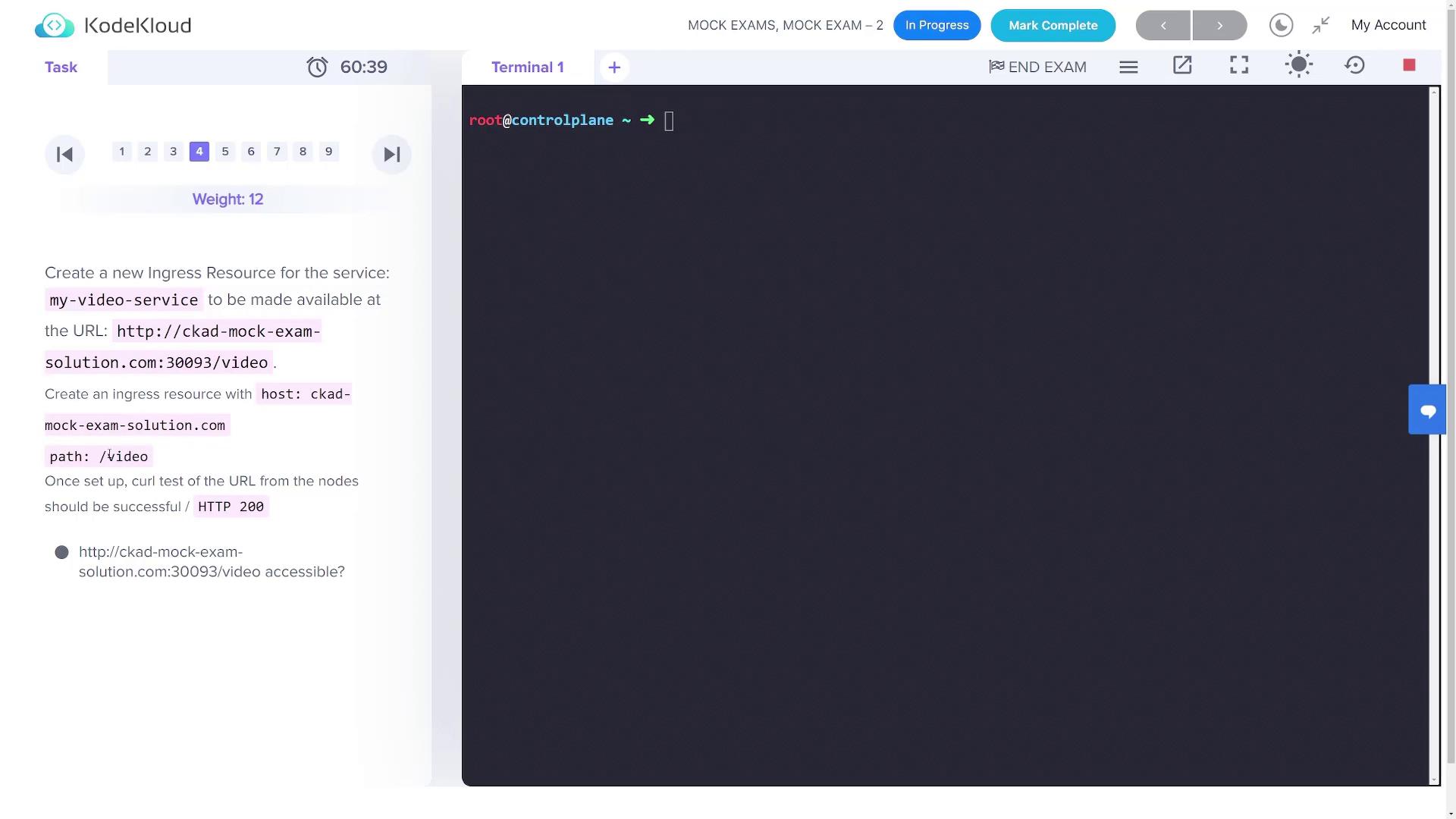
5. Update a Pod with a Readiness Probe
Update a pod (named pod-with-rprobe) to include a readiness probe. First, retrieve its current configuration:
kubectl get pod pod-with-rprobe -o yaml > pod.yaml
Edit pod.yaml and insert the following snippet under the container spec (before the ports section):
readinessProbe:
httpGet:
path: /ready
port: 8080
An updated container section should resemble:
containers:
- name: pod-with-rprobe
image: kodekloud/webapp-delayed-start
env:
- name: APP_START_DELAY
value: "180"
readinessProbe:
httpGet:
path: /ready
port: 8080
ports:
- containerPort: 8080
protocol: TCP
After saving your changes, force replace the existing pod:
kubectl replace -f pod.yaml --force
Verify the update:
kubectl get pod pod-with-rprobe
6. Create a Pod with a Liveness Probe
Create a new pod named nginx1401 in the default namespace using the nginx image. This pod will have a liveness probe that executes a command to check /var/www/html/probe. The probe has an initial delay of 10 seconds and executes every 60 seconds.
Create a file called nginx1401.yaml with the following content:
apiVersion: v1
kind: Pod
metadata:
name: nginx1401
namespace: default
spec:
containers:
- name: nginx1401
image: nginx
livenessProbe:
exec:
command: ["ls", "/var/www/html/probe"]
initialDelaySeconds: 10
periodSeconds: 60
Apply the configuration:
kubectl apply -f nginx1401.yaml
Tip
If validation errors occur, verify the YAML formatting and ensure the liveness probe is directly placed under the container.

7. Create a Job Called Whalesay
Create a Kubernetes Job named whalesay using the docker/whalesay image. This job will execute a command to display "I am going to ace CKAD!", with 10 completions, a backoff limit of 6, and a restart policy set to Never.
Generate the job configuration using a dry run:
kubectl create job whalesay --image=docker/whalesay -- /cowsay "I am going to ace CKAD!" --dry-run=client -o yaml > whalesay.yaml
Edit the whalesay.yaml file to include the completions and backoffLimit fields. The finalized YAML should be:
apiVersion: batch/v1
kind: Job
metadata:
name: whalesay
spec:
completions: 10
backoffLimit: 6
template:
spec:
containers:
- name: whalesay
image: docker/whalesay
command:
- sh
- -c
- "/cowsay 'I am going to ace CKAD!'"
restartPolicy: Never
Apply the job configuration:
kubectl apply -f whalesay.yaml
Monitor the job progress until all 10 completions succeed:
kubectl get jobs -w
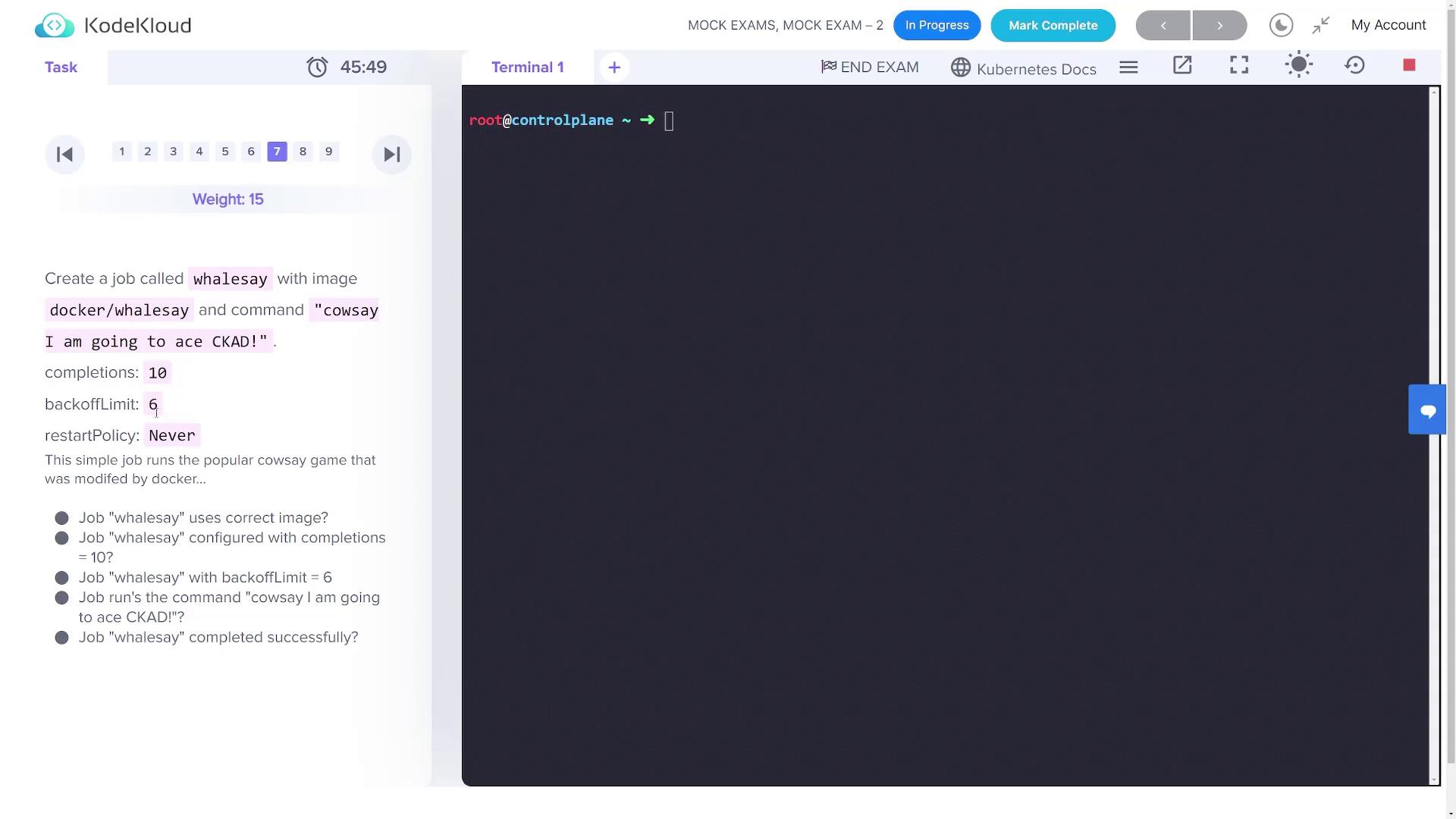
8. Create a Multi-Container Pod
Create a pod named multi-pod containing two containers with the configurations below:
- Container 1:
- Name: jupiter
- Image: nginx
- Environment Variable:
type=planet
- Container 2:
- Name: europa
- Image: busybox
- Command:
/bin/sh -c "sleep 4800" - Environment Variable:
type=moon
Create a file called multi-pod.yaml with the following content:
apiVersion: v1
kind: Pod
metadata:
name: multi-pod
spec:
containers:
- name: jupiter
image: nginx
env:
- name: type
value: "planet"
- name: europa
image: busybox
command: ["/bin/sh", "-c", "sleep 4800"]
env:
- name: type
value: "moon"
Apply the configuration:
kubectl apply -f multi-pod.yaml
9. Create a Persistent Volume
Create a persistent volume named custom-volume with these attributes:
- Storage: 50Mi
- Reclaim Policy: Retain
- Access Modes: ReadWriteMany
- Host Path: /opt/data
Create a file named pv.yaml with the configuration below:
apiVersion: v1
kind: PersistentVolume
metadata:
name: custom-volume
spec:
capacity:
storage: 50Mi
accessModes:
- ReadWriteMany
persistentVolumeReclaimPolicy: Retain
hostPath:
path: /opt/data
Apply the persistent volume configuration:
kubectl apply -f pv.yaml
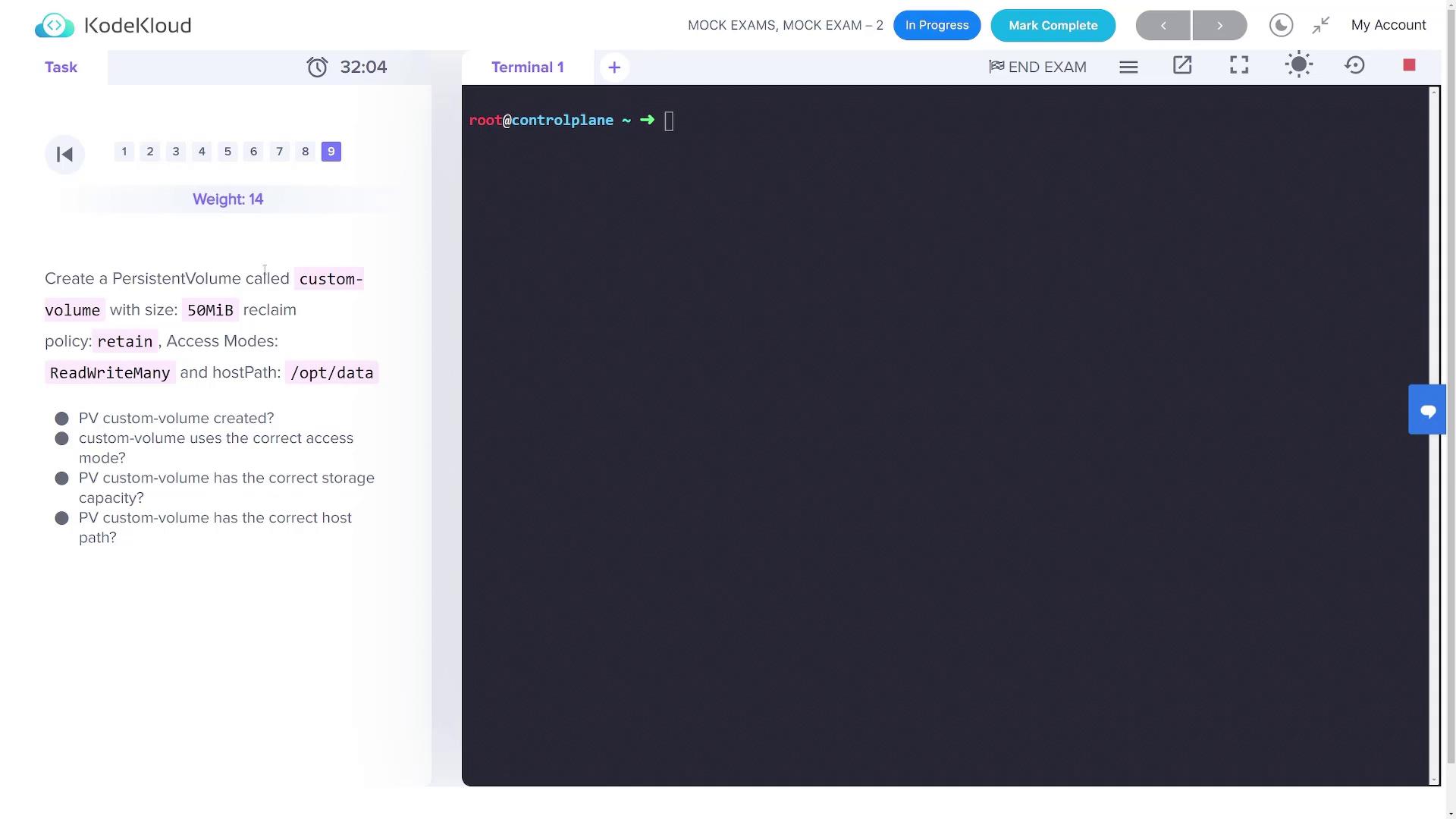
This concludes the mock exam solutions. Verify each resource with the appropriate kubectl commands to ensure all configurations are applied successfully. Enjoy scaling your Kubernetes expertise!
Watch Video
Watch video content